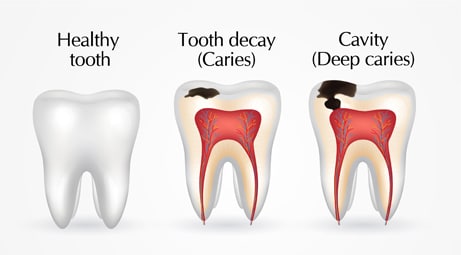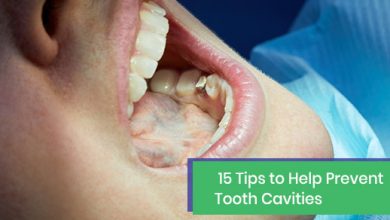What’s the Difference: Tooth Decay vs. Cavities?

Tooth decay is a progressive tooth disease caused by compromised enamel and exposure to harmful oral bacteria. A cavity, on the other hand, refers to the hole that forms in the tooth as the decay progresses through the tooth structure.
Both tooth decay and cavities are related, as tooth decay can lead to the formation of cavities. However, they are not the same thing. Tooth decay, also known as dental caries, is the underlying disease, while a cavity is a physical manifestation of that disease.
Understanding the difference between tooth decay and cavities is essential for maintaining good oral health and preventing further damage to the teeth. Dental care and preventive measures are crucial in stopping the progression of tooth decay and treating cavities to preserve natural teeth and oral well-being.
Understanding Tooth Decay
Decay is a progressive tooth disease caused when enamel is compromised and the tooth is exposed to harmful oral bacteria. A cavity is the hole that forms in your tooth as the decay works its way through your tooth structure.
No, tooth decay is not the same as a cavity. However, tooth decay can cause cavities. Tooth decay, or also referred to as dental caries, is the disease known as caries or cavities. Tooth decay is caused by certain bacteria in the mouth that thrive on sugars and refined carbohydrates.
When comparing tooth decay to a cavity, a cavity is a permanent area of damage within your teeth. These little openings or holes may need to be filled by your dentist. Technically, a cavity is a hole that has formed in the tooth as a result of the decay. A chipped tooth or broken filling might lead to a cavity. Cavities, also called tooth decay, are permanently damaged areas in the hard surface of your teeth that develop into tiny openings or holes.
The time it takes for a cavity to form varies. It can, on average, take anywhere from six months to four or five years before a cavity requires treatment. The length of time it takes will vary on a case-by-case basis because the conditions of your mouth differ daily.
Visible holes or pits in your teeth: Cavities form tiny openings in teeth that gradually become larger. Discoloration: Teeth with cavities may appear brown, black, or white.
Exploring Cavities
Tooth decay is a progressive disease caused by compromised enamel and exposure to harmful oral bacteria. A cavity, on the other hand, is the actual hole that forms as the decay progresses through the tooth structure. While tooth decay can lead to cavities, they are not the same thing.
Definition Of Cavities:
Tooth decay is a progressive tooth disease caused when enamel is compromised and the tooth is exposed to harmful oral bacteria. A cavity is the hole that forms in your tooth as the decay works its way through your tooth structure.
| Is Tooth Decay and a Cavity The Same Thing? |
|---|
| No, tooth decay is not the same as a cavity. However, tooth decay can cause cavities. |
| Are Dental Caries and Cavities the Same Thing? |
|---|
| The only difference between the two terms is that dental caries is the dental (or medical) term used to describe the very same process. |
Tooth decay is the disease known as caries or cavities. Tooth decay is caused by certain bacteria in the mouth that thrive on sugars and refined carbohydrates.
Tooth Decay and Cavities are not the same thing. However, one leads to the other. Tooth decay, also called dental caries, starts as plaque adheres to your teeth surfaces, and the acids produced by bacteria in the plaque slowly dissolve the enamel, leading to the formation of a cavity.
When comparing tooth decay to a cavity, a cavity is a permanent area of damage within your teeth. These little openings or holes may need to be filled by your dentist.
Technically, a cavity is a hole that has formed in the tooth as a result of the decay. A chipped tooth or broken filling might lead to a cavity.
Cavities, also called tooth decay, are permanently damaged areas in the hard surface of your teeth that develop into tiny openings or holes.
Every Cavity Is Different. The time it takes for a cavity to form varies. It can, on average, take anywhere from six months to four or five years before a cavity requires treatment. The length of time it takes will vary on a case-by-case basis because the conditions of your mouth differ daily.
Visible holes or pits in your teeth: Cavities form tiny openings in teeth that gradually become larger. Discoloration: Teeth with decay may have white spots, brown areas, or black holes.
When it comes to tooth decay, it’s crucial to maintain good oral hygiene practices such as brushing, flossing, and regular dental check-ups to prevent the formation of cavities.
Differences Between Tooth Decay And Cavities
Tooth decay and cavities are not the same thing. Tooth decay is a progressive disease caused by the exposure of teeth to harmful oral bacteria, while a cavity is the hole that forms when the decay works its way through the tooth structure.
Distinctive Characteristics Of Tooth Decay |
Unique Attributes Of Cavities |
How Tooth Decay Leads To Cavities |
|
Decay is a progressive tooth disease caused when enamel is compromised and the tooth is exposed to harmful oral bacteria. |
A cavity is the hole that forms in your tooth as the decay works its way through your tooth structure. |
Tooth decay is not the same as a cavity. However, tooth decay can cause cavities. Tooth decay, or also referred to as dental caries, is the disease known as cavities. |
|
Decay starts as plaque adheres to your teeth and weakens the enamel. Over time, this can progress and lead to tooth decay. |
A cavity is a permanent area of damage within your teeth that requires filling. |
Dental caries and cavities are essentially the same process, with dental caries being the medical term. |
|
Tooth decay is caused by certain bacteria in the mouth that thrive on sugars and refined carbohydrates. |
Cavities are holes or areas of tooth decay that form in your teeth surfaces. |
Cavities can develop from plaque buildup and consuming sugary snacks. |
|
The time it takes for a cavity to form varies, ranging from six months to several years before requiring treatment. |
A chipped tooth or broken filling can lead to the formation of a cavity. |
Visible holes or pits in your teeth are signs of cavities. |

Credit: www.choice-dental.com.au
Frequently Asked Questions On What’s The Difference Between Tooth Decay And A Cavity
Does Tooth Decay Always Mean Cavity?
Tooth decay and cavity are not the same. Decay is a progressive tooth disease caused by compromising enamel and exposure to harmful oral bacteria. A cavity is the hole formed as decay progresses through the tooth. Tooth decay can lead to cavities, but they are not interchangeable.
How Long Does It Take For Tooth Decay To Turn Into A Cavity?
Tooth decay can turn into a cavity anywhere from six months to four or five years. The time it takes varies for each individual, depending on the condition of their mouth. Cavities are formed when decay eats through the tooth structure, causing a hole to develop.
Regular dental check-ups can help prevent and detect tooth decay early.
Does Decayed Tooth Have To Be Removed?
Decayed tooth may need to be removed depending on the severity of the decay and the extent of damage to the tooth structure. Treatment options include filling, crowning, or root canal therapy. It is important to consult with a dentist to determine the best course of action.
What Does Tooth Decay Look Like?
Tooth decay can be identified by visible holes or pits in your teeth. Cavities start as tiny openings that gradually become larger. Discoloration may also occur, with affected teeth appearing yellow, brown, or black. Additionally, throbbing pain in your teeth is a sign that the decay has reached the tooth’s pulp.
Conclusion
Tooth decay and cavities may seem like the same thing, but they have distinct differences. Tooth decay refers to the progressive disease caused by compromised enamel and exposure to harmful bacteria. On the other hand, a cavity is the actual hole that forms in the tooth as decay progresses.
While tooth decay can cause cavities, they are not synonymous. It’s important to understand these differences and take preventative measures to maintain optimal dental health. Regular dental check-ups, proper oral hygiene, and a healthy diet can help prevent both tooth decay and cavities.
Take care of your teeth to ensure a bright and healthy smile for years to come.





